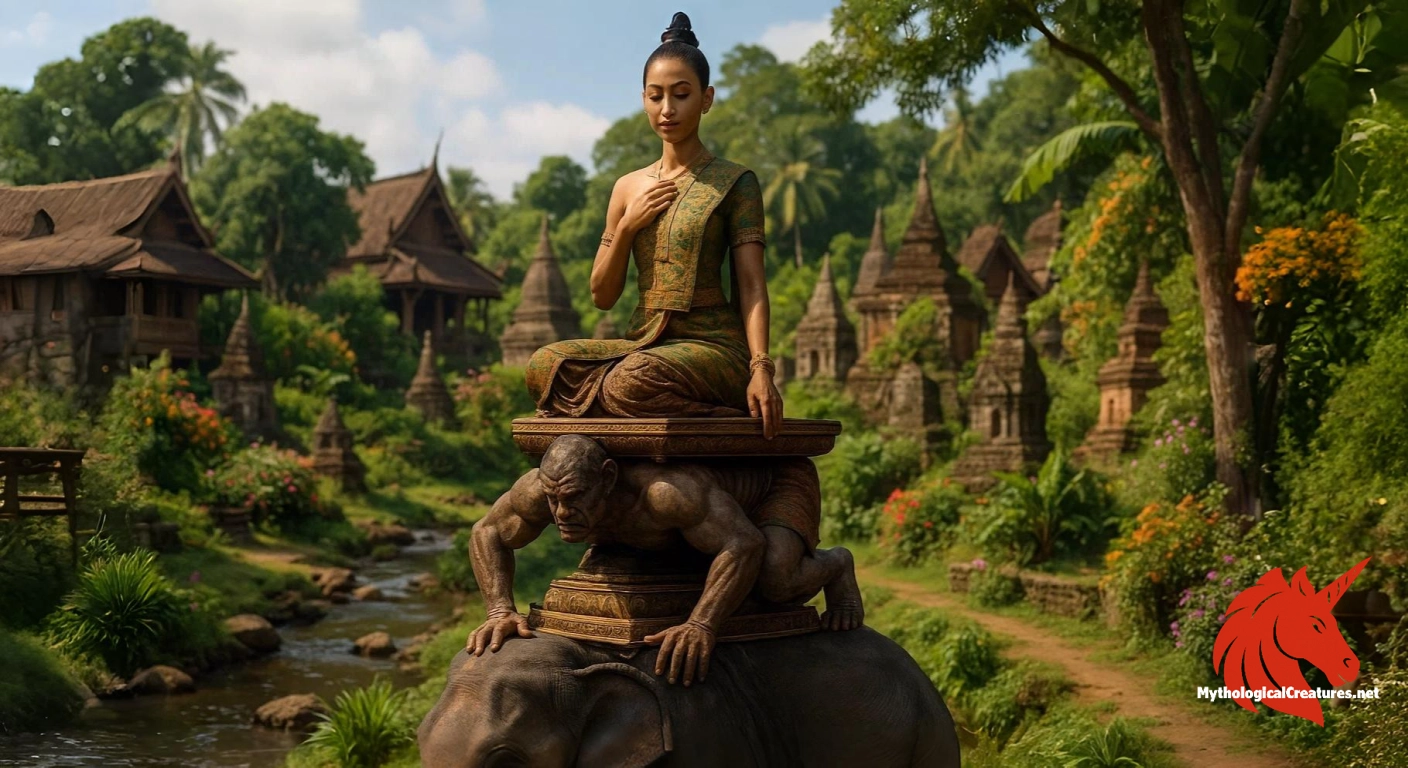Thonbanhla: Thonbanhla is the fifth of the official Burmese nats, renowned for her beauty and tragic fate.

Thonbanhla
Thonbanhla - Embodies the themes of beauty, jealousy, and tragic fate within Burmese lore.
Origins & First Encounters
Thonbanhla occupies a unique place among the official Burmese nats, celebrated as much for her tragic fate as for her transcendent beauty. Her origins trace back to the Mon village of Takunnwan, a detail that enriches her legend with regional authenticity. Legends recount that she was renowned for being 'beautiful in three ways within one day,' a phrase that hints at the mutable nature of aesthetic perfection. Her story intertwines themes of love, deception, and societal expectations, offering insights into the complexities of ancient Burmese royal intrigues. The narrative of her life serves as a cultural bridge between indigenous Mon traditions and the broader Burmese spiritual landscape. As her tale evolved, it highlighted the tensions between inner virtue and external appearances, reflecting societal preoccupations with beauty and honour. The myth of Thonbanhla is embedded in a tapestry of folklore that underscores the interplay between mortal experiences and divine interventions. Her enduring presence in the nat pantheon continues to fascinate and influence both traditional beliefs and contemporary interpretations. Through her legend, audiences are invited to contemplate the transient and often bittersweet nature of beauty and fate.
Source Texts & Tale Variants
The story of Thonbanhla has been preserved through a variety of traditional sources, ranging from temple inscriptions to oral performances in village settings. Ancient chronicles and state-endorsed narratives have recorded her life with dramatic detail, embedding her memory within the official pantheon of Burmese nats. Distinct variants of her tale exist, one of which tells how she was given to King Duttabaung of Pyay before courtly jealousy led to her tragic rejection. Another tradition recounts her as the younger sister of Maung Tint De who married King Smim Htaw Yama of Utthala and bore a daughter named Shin Mi-hnè before succumbing to a sudden illness. These narratives have been transmitted by storytellers, ritual dance performers, and dramatists throughout the ages. Each version of her story emphasises different facets of her character, whether her beauty, familial bonds, or the sorrow borne of betrayal. The multiplicity of accounts not only underscores the rich diversity of Burmese myth but also reflects the fluidity of folklore in adapting to regional tastes. Oral traditions and performance arts continue to play a vital role in keeping her legacy alive, thereby reinforcing her place in the cultural consciousness. Such sources, both written and oral, contribute to a layered understanding of Thonbanhla’s multifaceted persona.
Form & Powers
In artistic renderings, Thonbanhla is frequently portrayed in a state of refined elegance that captures both her physical beauty and the sorrow of her destiny. She is often depicted standing atop an ogre, bending gracefully over a dais supported by an elephant, a composition that symbolises the complex interplay between power and vulnerability. Her appearance is marked by an immaculate topknot and flowing garments that suggest a blend of royal poise and otherworldly charm. The meticulous details in her visage reveal delicate, symmetrical features, and her eyes are often rendered with an almost ethereal glow that speaks to her mystic origin. Her right hand is thoughtfully placed on her chest, conveying a sense of inner emotion and quiet dignity, while her left hand rests by her side in a posture of calm acceptance. The use of subtle, harmonious colours in traditional paintings accentuates the luminous quality of her skin, contrasting with darker elements that hint at her tragic end. Intricate jewellery and headdresses are sometimes incorporated into her portrayal, reinforcing her connection to both earthly royalty and spiritual realms. Variations in her iconography, including slight differences in posture and scale, have been carefully maintained through centuries of artistic expression. Overall, the visual depictions of Thonbanhla remain as rich and evocative as the layers of meaning embedded in her myth.
Regional Faces
Regional adaptations of Thonbanhla’s myth have played a significant role in shaping her varied portrayals across different communities in Myanmar and beyond. While her core narrative is rooted in Burmese culture, local traditions have imbued her story with nuances that reflect regional artistic and religious sensibilities. In many rural areas, performances at festivals and rituals present her as an emblematic figure whose beauty and sorrow serve as moral parables. Mon cultural retellings, in particular, tend to highlight her origins and romanticise the aspects of her life that underscore a deep connection to local heritage. Some communities accentuate the elements of betrayal and jealousy in her tale, using her story as a cautionary narrative against the dangers of envy. In contrast, other regions focus on the transcendent qualities of her beauty, portraying her as a timeless muse whose presence elevates communal celebrations. Local adaptations often incorporate unique symbolic motifs, with artistic embellishments that resonate with indigenous spiritual practices. These diverse regional interpretations demonstrate how Thonbanhla’s myth is not static but continuously enriched by the voices of different cultural groups. As a result, her story evolves while still retaining the core themes that make her an enduring icon in Burmese folklore.
Cultural Parallels
Thonbanhla’s narrative shares thematic resemblances with mythological figures from various cultures, highlighting common motifs of beauty intertwined with tragic destiny. Her story echoes the archetype of a fated beauty whose allure invites both adoration and eventual misfortune, a theme seen in diverse traditions like the tragic heroines of classical Greek myths. Much like the ill-fated nymphs and heroines whose beauty precipitates conflict and eventual downfall, her legend encapsulates a cautionary tale about the vicissitudes of fortune. Comparative mythologies often feature divine figures whose charms are both revered and resented, a duality that Thonbanhla embodies through her celebrated yet sorrowful life. Her portrayal also invites parallels with supernatural spirits in Southeast Asian folklore who serve as mediators between the mortal and divine realms. The emphasis on her layered beauty, which transforms throughout the day, resonates with other cultural narratives that view beauty as a transient and multifaceted phenomenon. By examining her legend alongside those of other cultures, one finds a shared exploration of envy, fate, and the impermanence of physical allure. These cross-cultural connections enrich the interpretation of her story, reinforcing her status as more than a regional figure but as part of a larger mythic dialogue. Ultimately, Thonbanhla’s tale stands as a testament to the universal interplay between beauty, power, and tragedy found throughout world mythology.
Legacy & Modern Evolution
Thonbanhla’s myth has evolved over many centuries, reflecting the dynamic interplay between traditional beliefs and contemporary cultural expressions. Initially shaped by oral traditions and ritual performances, her story was enshrined in the official pantheon of Burmese nats, ensuring its transmission through generations. Over time, artists, playwrights, and scholars have reinterpreted her narrative, often highlighting the delicate balance between her celebrated beauty and the sorrowful cost of societal envy. Modern depictions frequently cast her as a symbol of resilience, urging audiences to question conventional notions of beauty and worth. Contemporary artworks reinterpret her image with renewed vitality, blending classical iconography with modern aesthetics to create dynamic visual narratives. Her evolving portrayal has also spurred discussions about the role of women in myth, with some viewing her tragic fate as a commentary on the vulnerabilities inherent in female beauty. Festivals and cultural events in Myanmar continue to celebrate her legacy as part of a broader nat tradition, ensuring that her spirit remains an active element of cultural heritage. As reinterpretations flourish in cinema, literature, and visual arts, Thonbanhla’s narrative continues to inspire dialogue about the intersections of history, art, and identity. Through such modern legacies, her myth endures as a multifaceted symbol, bridging ancient spiritual traditions with the sensibilities of today.
Interesting Fact
An intriguing aspect of Thonbanhla’s legend is the existence of multiple, sometimes conflicting narratives about her life, which underscores the rich diversity of Burmese mythological traditions.
Quick Creature Info
Origin:
Associations:
Our Mythic Legendary Rating:

Habitat:
Physical Attributes:
Behavior:
Lore:
Related Creatures, Tales or Lore
- MMaung Tint De
- TThagyamin
- MMin Mahagiri
References
Discover Another Mythical Legend You May Not Have Heard Of?
Uncover the mysteries of ancient folklore and expand your knowledge of legendary beings from cultures around the world.
Dare to Meet the Cleocharia....
Mythical Disclaimer: The images and data on this site are derived from various historical and literary sources, but we have found that many myths often have multiple versions and interpretations across references, sometimes contradictory. As a result, these creature depictions are artistic interpretations—imaginative blends of folklore, legend, and a dash of AI guesswork. Because creature descriptions vary widely, our illustrations and accompanying information represent our best effort to honor mythology while bridging creative gaps. Enjoy these interpretations—just remember, we've done our best to respect the stories and validate available data, but in the realm of mythology, details often shift, imagination leads the way, and nothing is ever set in stone!
Curated by the Mythological Creatures Team (rev. May 2025)
